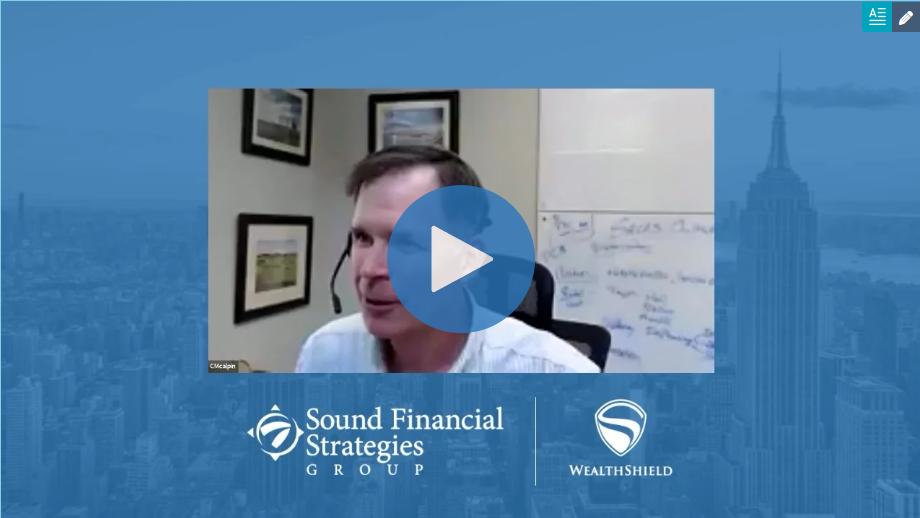What’s Going On in the Markets?
Stocks Suffer Biggest One-Day Wipeout in Value Since March 2020 is the headline of the Wall Street Journal at the end of the day on April 4, 2025....
5 min read
 Chris McAlpin
:
Nov 14, 2023 7:47:45 AM
Chris McAlpin
:
Nov 14, 2023 7:47:45 AM

Why aren’t we making more money? “Why am I not making more money, and how can we fix that?”
Over the past couple of months, this is the question I’ve had folks ask me the most. Without a doubt, I’m sure a few of you reading this are watching the news and markets. You’re seeing what’s happening in the world, and you may be wondering the same thing for yourselves.
To answer that question, we need to look backward to understand how we got here. Because what we are experiencing today has deep roots in the past.
We are four years into a monumental event.
This is something that has never happened in our lifetimes.
The Federal Reserve and the U.S. government collectively pushed trillions of dollars into the economy and into the markets. This caused massive inflation, to which the Federal Reserve responded by raising interest rates 5.5% over 18 months.
🔎 Related: Is the stock market gambling?
On top of that, we had a war going on in the breadbasket of the world … whereas today, we have a war going on in the gas station of the world, and that is going to cause problems all over. Even with the best possible responses, these events inevitably have an effect on the markets, which is where we manage money for you.
When we say “real assets,” we’re talking about lots of different things. Real assets are land. Real assets are businesses. Real assets are equipment. Real assets are assets that directly produce an income of financial assets.
🔎 Related: How does the U.S. economy work? (an accessible overview)
When it comes to financial assets, we have stocks, bonds, annuities. It’s an alternative, a security that represents a real asset somewhere. For example, if you own stock in AT&T, you own a slice of ownership of a real company. But that stock is a financial asset, whereas AT&T is the real company itself.
Here is what you need to know:
However, there are still opportunities we want to take advantage of. Yes, the Dow Jones Industrial Average is going back to 2019, remaining flat since April 2021. That means that, for many of us, our stocks have given us some returns, but then the stocks took those returns away from us.
When we talk about dividend stocks, we’re talking about good old, solid, high quality companies like Walmart, Coca Cola, Pepsi, and Lowe's. These are companies that most likely aren't going anywhere, right? Sure, they could make a mistake, and no one can predict the future with the stock market. But, for the most part, they’re reliable.
All of these stocks bottomed out in October 2022. No matter whether you’re looking at the S&P 500 or Nasdaq, the story is the same — albeit with higher highs and lower lows. If I pulled up our dividend growth stocks, and I turned them into an index, you would see the same thing, because this is a broad, systemic event.
Of course, again, bonds have also been disastrous. If you look at the 10 Year Treasury, you would see that it’s been -23% over the last three years. This is the U.S. Treasury Bond that, in every math formula in the industry, is considered the risk-free rate of return — which is what makes this data hard to digest.
🔎 Related: Why the U.S. stock market must crack (our commentary)
It started because of the anticipation.
It started because the bond market could see the inflation seeping into our economy — and they knew the Fed was gonna lower interest rates. However, they had no clue that we were going to lower interest rates 5.5% percent over 18 months.
Many of our clients have heard me say this, but I’ll say it again – 2022 is the worst year of my career from a management standpoint, because we rotate from stocks to bonds to be conservative, as a meaningful percentage of our clients are retired.
🔎 Related: Tax savings strategies for high income earners (+ examples)
It’s our job to look at this state of affairs and say that, honestly, this stinks. It’s made our jobs very hard, it’s made your jobs very hard. It’s extremely difficult to look at the news and feel good.
These circumstances, unfortunate as they are, have created opportunities that we haven’t had in 20 or 25 years. Specifically, as bond prices have gone down, the yield has gone up. Bond prices and bond yields move opposite of each other.
We have been in the worst bear market in the bond side of the financial markets in history, because the Fed flooded the financial markets with money. And when they flooded the financial markets with money, the price of that money — which is also reflected in the price of bonds — goes down.
It’s the opposite of inflation in this, because you had an oversupply of money. It suppresses the price, which runs the yields up. That started happening before the Fed started driving the yields up themselves.
Think about it like this …
In the stock market, you have buyers and you have sellers, and let’s say they're buying and selling widgets. During COVID-19, all of those sellers got sent home and couldn’t work anymore. So, the production of those widgets went way down. All of those sellers of the widgets became buyers, because the government gave them money.
🔎 Related: Investment strategy, the Sound Financial way
That meant the buying power of the buyers doubled, but the production power of the sellers got cut in half, creating massive inflation. The Fed controls that by raising the price of the money, therefore taking money out of circulation. When that happened, it created what we’re seeing today, with bond prices bottoming out.
In this case, the market is giving us an opportunity on the fixed income side. That’s why, recently, we rebalanced all of our portfolios.
We’re holding a percentage of dividend stocks. We added a pretty hefty sleeve of alternative investments that we think would do well in a negative, sideways, or just volatile market, in general. We also started stepping in and buying bonds and ETFs.
Now, we’re not telling anyone to go rush out and buy AGG, right? But when we see sell-offs, we do start to look for opportunities.
This is the second question we are getting the most often, recently. We're in the middle of some dark economic times right now. But we've been here before as a country. Yes, times like these can look bleak — of course, God has His plans, and He is in control.
The United States is economically independent, militarily independent, agriculturally independent, energy independent, and so on. We also control the world's financial markets. I get the question about the strength of the dollar a lot. Yes, Russia, China, and India, and everybody would love to decouple from the dollar.
They can't yet. No empire sits on the throne without anybody challenged. They're going to get challenged all the time. But we actually see a lot of good ahead over the next 10 to 20 years.
The stock market is going to go through some tough times over the next three to five years, we believe, so now is a good time to take advantage of these good fixed-income opportunities.

Stocks Suffer Biggest One-Day Wipeout in Value Since March 2020 is the headline of the Wall Street Journal at the end of the day on April 4, 2025....

Understanding where we are in the market cycle is key to making sound investment decisions. At Sound Financial Strategies Group, we take a...

The financial markets in early 2025 are flashing cautionary signals, prompting investors to consider a more defensive stance. As I write this...

{% video_player "embed_player" overrideable=False, type='hsvideo2', hide_playlist=True, viral_sharing=False, embed_button=False, autoplay=False,...

The financial landscape in April 2025 has been marked by significant volatility, driven by geopolitical developments and shifts in economic policy....

Welcome to Moneyville Once upon a time, in a town not too far away, there was a place called Moneyville. In Moneyville, everything seemed perfect....